The size and habitat of River Otters and Sea Otters are the main differences between them. River otters are smaller than Sea otters. They live in freshwater, such as lakes and rivers, whereas sea otters live in ocean waters. Sea otters have a thicker coat that allows them to withstand the extremely cold ocean waters, whereas river otters have a sleeker coat.
However, that’s only the beginning of their differences. These otters are worlds apart when we talk about their diets and social structures.
Sea Otters eat clams, mussels, and sea urchins. In contrast, River Otters have a more varied diet, munching on fish, frogs, and insects. Likewise, River Otters are more social than Sea Otters.
Intrigued yet? We’ve only scratched the surface! Keep reading this blog to discover more about the River and Sea Otters and what makes them unique. Trust us! You won’t be disappointed. There’s a lot to explore!
River Otters Vs Sea Otters – Quick Comparison Chart
| Parameters | River Otters | Sea Otters |
| Genus | Lontra | Enhydra |
| Habitat | Rivers and seas | Seas only |
| Appearance | Slender with a long tail, round head with small ears and eyes; grayish-brown fur | Wide and furry body, short tail; Flat head with large ears and eyes; reddish-brown fur |
| Behavior | Social | Solitary |
| Diet | Fish, rodents, birds, and reptiles | Clams, mussels, and sea urchins. |
| Lifespan | 9-12 years | 12-15 years |
| Size | 3-4 feet long; 15-20 pounds | 3-5 feet long; 20-80 pounds |
| IUCN Status | Least Concern | Endangered |
| Common Names | Freshwater Otters, or Common Otters | Ocean Otters or Marine Otters |
River Otters Vs Sea Otters – What Are the Key Differences?

Sea and river otters are like two sides of the same coin. Both are fascinating but have unique features that set them apart. Both are members of the Mustelidae family.
They are present in many parts of the world. Their short, stubby arms are paired with long spines. They love playing with rocks and toys and wrestling with each other. However, they differ in some ways. Let’s discuss the side-by-side differences between them.
1. Scientific Classification
River Otters
River Otters belong to the subfamily Lutrinae. They are also known as ‘freshwater Otters’ or ‘common Otters.’
The North American river otter (Lontra canadensis) is the most prevalent river otter species. It inhabits most of Canada, the U.S., and Mexico. Other species are
- Neotropical River Otters (Lontra longicaudis)
- Southern River Otters (Lontra provocax)
- Marine Otters (Lontra felina)
- Eurasian Otters (Lutra lutra)
Sea Otters
Sea Otters (Enhydra lutris) are also members of the subfamily Lutrinae. However, they are the only species in the genus Enhydra. They have three subspecies:
- The Northern sea otter (Enhydra lutris kenyoni),
- The Southern sea otter (Enhydra lutris nereis),
- The Asian sea otter (Enhydra lutris lutris).
They are also known as ‘ocean Otters’ or ‘marine Otters.’
2. Habitat and Distribution
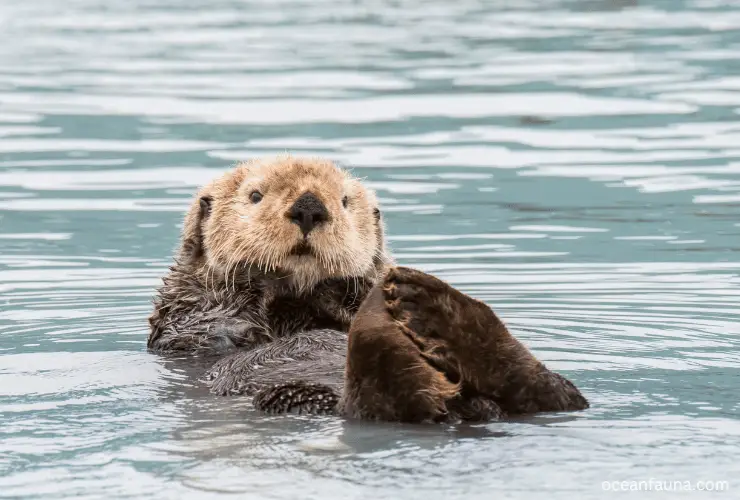
River Otters
River Otters live in freshwater habitats like rivers, lakes, and wetlands. They can also venture into saltwater areas but prefer freshwater sources. They are adaptable and inhabit diverse climates and ecosystems, from tropical rainforests to temperate forests. You can find them in
- North America
- South America
- Europe
- Asia
- Africa.
River Otters need access to both land and water, as they use both for hunting, resting, grooming, and denning. They usually dig their own dens or use existing ones made by other animals, such as beavers.
They prefer habitats with abundant fish, aquatic vegetation, and dense cover along the banks for shelter. They have an extensive home range varying from 2 to 30 km2.
Sea Otters
Sea Otters or Ocean Otters live exclusively in marine habitats like rocky shores, kelp forests, coral reefs, and open oceans. They rarely go on land, except for females who give birth or nurse their pups on rocky shores. You can find them in
- Pacific Ocean
- Russia
- Japan
- Alaska
- California
Fun fact: Sea Otters are among the few animals that sleep on the water!
They do not dig dens or burrows. Instead, they wrap themselves in kelp or hold hands to avoid being carried away. They have a smaller home range than river otters, typically 0.5 to 16 km2.
| Feature | River Otters | Sea Otters |
| Habitat | Freshwater | Marine |
| Distribution | North America, Europe, Asia | North Pacific Ocean |
| Range | 2 to 30 km2 | 0.5 to 16 km2 |
| Live on Land | ✓ | |
| Denning | ✓ |
3. Physical Appearance
River Otters
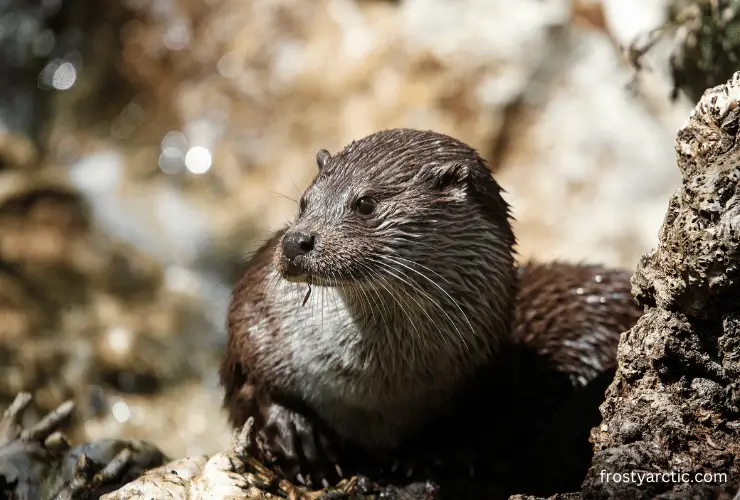
- Body: River otters have slender and streamlined bodies.
- Tail: They have a long, tapered tail that is about a third of their total body length. Their tail acts as a rudder and helps them steer and balance in the water.
- Legs: They have shorter legs with webbed feet.
- Claws and teeth: River Otters have sharp teeth and claws for gripping slippery prey and surfaces.
- Ears and Eyes: They have round heads with small ears and eyes on the top of their heads. This allows them to see above the water’s surface while swimming.
- Fur: River Otters have a sleek fur coat that repels water and keeps them dry. Their fur is brown or grayish, with lighter patches on the throat and chest.
- Size: They grow almost 4.6 feet long and weigh approximately 14 kg.
- Metabolism: River Otters have a lower metabolism, allowing them to survive on less food.
Sea Otters

- Body: Sea otters have a compact and bulkier body shape than river otters.
- Tail: They have a short and flattened tail about a fifth of their body length. Their tail helps them stabilize and maneuver in the water.
- Legs: Sea otters have long legs with large, webbed feet.
- Claws and Teeth: They have strong teeth and blunt claws to crack open shells and other tough prey items.
- Ears and Eyes: They have flat heads with large ears and eyes on the sides of their heads. This gives them a wider field of vision underwater while diving.
- Fur: Sea otters have dense fur coats. It traps air bubbles for insulation as they lack an insulating fat layer. The fur is usually brown or reddish-brown, with lighter patches on the head and neck.
- Pouch: They also have a pouch under their arm to store rocks or shells.
- Size: They can grow almost 5 feet long and weigh approximately 45 kg.
- Metabolism: Sea otters have a high metabolism that requires eating about 25% of their body weight daily.
Did you know? Sea otters have the thickest fur among all mammals, with a whopping one million hairs packed into each square inch.
| Physical Feature | River Otters | Sea Otters |
| Average Length | 3.3 – 4.9 ft (1-1.5 m) | 3.9 – 5.9 ft (1.2-1.8 m) |
| Average Weight | 5-14 kg | 14-45 kg |
| Fur Color | Brown, grayish | Brown, reddish-brown |
| Tail Shape | Long, tapered | Short, flattened |
| Head Shape | Round head | Flat head |
| Ears and Eyes | Small | Large |
| Legs | Short legs with small webbed feet | Long legs with large webbed feet |
| Metabolism | Low | High |
4. Diet and Feeding Habits
River Otters

River Otters are carnivorous and feed on a variety of prey, like
- Fish
- Amphibians
- Crustaceans
- Reptiles
- Birds
- Small mammals.
They hunt mostly at night or during dawn and dusk. They dive underwater and use their whiskers to detect vibrations from their prey. They often bring their prey to the shore to eat it.
Did you know? River Otters can dive up to 66 feet deep and stay underwater for about 8 minutes.
Sea Otters
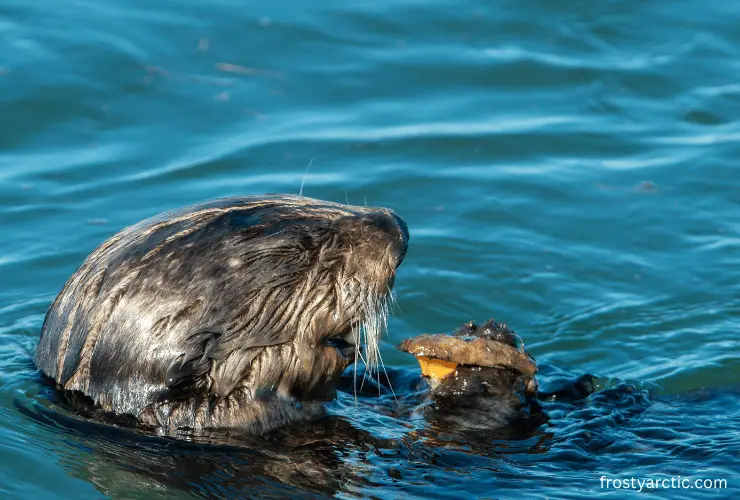
Sea Otters are also carnivorous and feed on a variety of marine prey, like
- Fish
- Crustaceans
- Shellfish
They hunt mostly during the day or at night when there is moonlight. They use their whiskers and paws to dig up or pry open their prey. They usually eat prey on their chests or backs while floating on the water’s surface.
Did you know? Sea Otters can dive up to 330 feet deep and stay underwater for about 5 minutes.
| Food Type | River Otters | Sea Otters |
| Fish | ✓ | ✓ |
| Amphibians | ✓ | |
| Birds | ✓ | |
| Crustaceans | ✓ | ✓ |
| Shellfish | ✓ | |
| Reptiles | ✓ | |
| Small mammals | ✓ | |
| Feeding Behavior | Nocturnal | Diurnal |
5. Social Behavior
River Otters
River Otters are considerably social creatures. They live in small family groups consisting of the mom and her pups. They love sliding, wrestling, and chasing each other. This playful behavior helps them form social bonds, practice hunting skills, and remain fit.
Did you know? The giant river otter lives in extended family groups of up to 20 individuals centered around a closely bonded breeding pair. These packs are cooperative, and the male raises the young, like wolf packs.
Sea Otters
Sea otters are also social animals that form groups called rafts. However, their social structure is less cohesive than River Otters. Sea otters tend to associate with others of the same sex and age class, and they often drift apart and rejoin different rafts.
They spend much time grooming their fur to maintain its insulation properties. They also rest together in their rafts, often wrapping themselves in kelp to stay anchored in one place.
| Behavior | River Otters | Sea Otters |
| Group Living | ✓ | |
| Solitary | ✓ | |
| Rafting | ✓ | |
| Vocalizations | ✓ | ✓ |
6. Reproduction and Lifecycle
River Otters
- Fertilization: River Otters mate in late winter or early spring and have delayed implantation of the fertilized egg. This means that the embryo does not start developing until the following winter or spring.
- Gestation Period: The gestation period lasts about two months.
- Pups: The female births one to six pups in a den near the water. The pups are born blind and helpless. They depend on their mother for milk and protection. The pups open their eyes after a month and explore outside the den after two months. They stay with their mother for about a year.
River otters become sexually mature at two to three years of age. They can live up to 16 years in the wild.
Sea Otters
- Fertilization: Sea otters mate throughout the year and have no delayed implantation of the fertilized egg.
- Gestation Period: The gestation period lasts about six months. The female births one pup on the water’s surface or land.
- Pups: The pup is born with fur and can see and hear but cannot swim or dive yet. The pup depends on its mother for milk and warmth and rides on her chest or back when foraging for food. The pup stays with their mother for about six months.
Sea Otters become sexually mature at two to five years of age. They can live up to 23 years in the wild.
| Aspect | River Otters | Sea Otters |
| Mating System | Polygynous | Polygynous |
| Gestation Period | 60 – 63 days | 6 – 9 months |
| Litter Size | 1 – 6 pups | 1 pup |
| Pup Dependency Period | 12 – 18 months | 6 – 8 months |
| Age of Sexual Maturity | 2 – 3 years | 3 – 5 years (females), 5 – 6 years (males) |
| Lifespan | 16 years | 23 years |
7. Predators
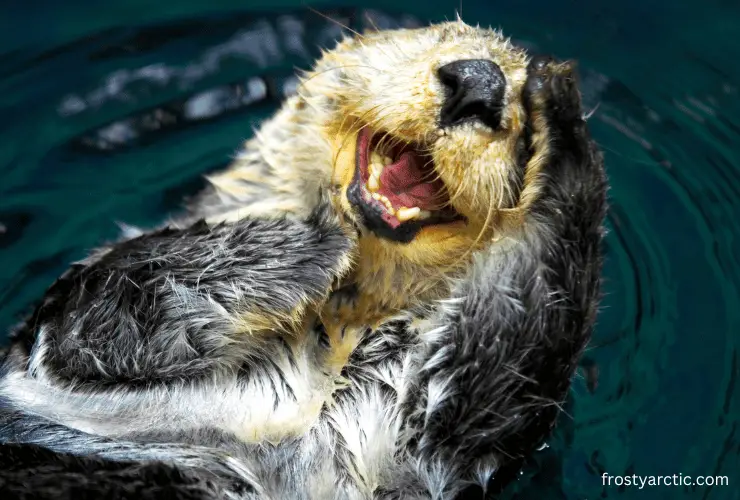
River Otters
River Otters have few natural predators. But some animals who hunt them are
- Coyotes and Bobcats
- Wolves
- Eagles
- Rodents
- Lizards.
Sea Otters
Sea Otters have more natural predators than River Otters, such as
- Sharks and Killer whales
- Sea lions
- Eagles
- Bears.
- Clams
- Mussels
- Sea urchins.
| Predators | River Otters | Sea Otters |
| Birds | ✓ (e.g., eagles) | ✓ (e.g., eagles) |
| Land Mammals | ✓ (e.g., coyotes, bobcats) | |
| Marine Mammals | ✓ (e.g., sharks, killer whales) | |
| Mollusks | ✓ (e.g., clams, mussels) |
8. Interactions with Humans
River Otters
River Otters have a complex relationship with humans. On the one hand, they are valued for their fur, meat, and role in controlling fish populations.
On the other hand, they are sometimes considered pests or disturbances for raiding fish farms. River Otters are also famous attractions in zoos and aquariums, where they show off their fun and nosy personalities.
Sea Otters
Sea Otters have a similar relationship with humans as River Otters. On the one hand, they are admired for their cuteness and role in maintaining kelp forests.
On the other hand, they are sometimes persecuted for competing with fishermen or damaging shellfish beds. Sea Otters are also popular attractions in zoos and aquariums, where they charm visitors with their antics and skills.
| Interaction | River Otters | Sea Otters |
| Human Encounters | Occasional | Frequent (in some coastal areas) |
| Ecotourism | ✓ | ✓ |
| Fur Trade History | ✓ | ✓ |
| Role in Ecosystem | Keystone species in freshwater ecosystems | Keystone species in coastal ecosystems |
9. Threats and Conservation Status
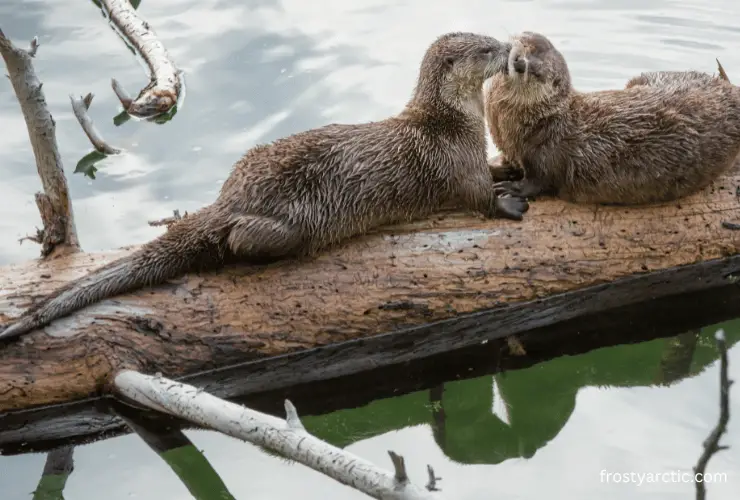
River Otters
River Otters are classified as “Least Concern” by the IUCN. They aren’t in danger of extinction. Yet, it’s not all smooth sailing for these Otters. Some populations may still be at risk due to habitat degradation or overexploitation.
Sea Otters
The IUCN classified sea otters as “Endangered.” They are at high risk of being extinct in the wild. These adorable creatures have faced many challenges over the years, with humans being one of the biggest threats to their survival.
In the 18th and 19th centuries, people hunted them for their luxurious fur, and this almost wiped them out completely. Though their numbers have increased slightly since then, sea otters still face many challenges. Oil spills, disease outbreaks, and climate change affect their population.
| Status | River Otters | Sea Otters |
| Least Concern | ✓ | |
| Endangered | ✓ | |
| Conservation Efforts | ✓ | ✓ |
| Human Impact Mitigation | Habitat restoration, pollution control | Oil spill prevention, sustainable fishing practices |
How Important Are River Otters and Sea Otters To The Ecosystem?
River Otters and Sea Otters are both important for maintaining the ecosystems’ balance and diversity.
River Otters
- River Otters help control the populations of their prey species, which can otherwise overgraze aquatic plants and algae. This helps preserve the water quality and oxygen levels for other animals.
- They also disperse seeds and nutrients through their feces. This, in turn, fertilizes the soil and vegetation along the riverbanks.
- River Otters are sensitive to environmental changes. So, they are effective indicators of environmental health.
Sea Otters
- Sea Otters help keep kelp forests healthy, which are vital for many marine species. They eat sea urchins, which can otherwise destroy the whole forest. By controlling the sea urchin population, sea otters allow the kelp to grow healthy. And that’s swell news for all the other animals that depend on it for food and shelter.
- They also help fight climate change by helping the kelp forests grow.
Are Sea Otters and River Otters Related?
Sea and River Otters are closely related, like two peas in a pod. They diverged from a common ancestor 5 million years ago. So, they belong to the same family and subfamily. But don’t let that fool you. They’re not identical twins! Sea otters are in the Enhydra genus, while river otters belong to Lontra.
They share some similarities but have their own unique personalities. For instance, sea otters have thick fur to warm them in chilly ocean waters. Meanwhile, river otters have long tails to help them navigate rivers and streams.
Sea Otter Vs River Otter: Who Would Win?
It is difficult to say who would win in a fight between a sea otter and a river otter. This is because these two otter species rarely meet in the wild. Assuming they did, the result would depend on their size, strength, agility, and aggressiveness.
- Sea otters are bigger and heavier, weighing up to 100 pounds. While river otters are sleeker and more agile.
- Sea otters use their large, paddle-like back flippers to swim. On the other hand, river otters have smaller feet and use all four paws for swimming in a doggy paddle style. So, they swim almost twice as fast as sea otters underwater.
- Both otters have sharp teeth and claws and can defend themselves if threatened. However, neither otter is likely to attack the other without provocation. These animals avoid conflict and instead focus their energy on finding food.
FAQs
Q: How do river otters and sea otters communicate with each other?
A: River otters and sea otters use vocalizations and body language to communicate with each other. They mark their mates and territories with urine, feces, and secretions from their scent glands.
- River otters make chirping, whistling, and growling sounds to express their emotions and intentions.
- Sea otters communicate with grunts, snorts, and squeals.
Q: Are River otters nicer than sea otters?
A: Well, the answer isn’t a simple yes or no. Both creatures have their own personalities. But, based on their behavior and dealings, we can make some general remarks.
- River otters are like class clowns. They love to play, socialize, and goof around. They’ll groom each other, wrestle, and even enjoy a slide.
- Sea otters, in contrast, are more like lone wolves. They are territorial creatures, fiercely defending their food and loved ones from strangers.
Q: Are River otters bigger than sea otters?
A: No! It’s actually the opposite. Sea otters are the biggest in the weasel family, while river otters are smaller.
Q: Are Sea otters and river otters the same?
A: No! Sea otters and river otters are different. Yes, they both belong to the same family, but they have unique features that suit their way of life.
Q: Are River otters dangerous?
A: River otters are generally not dangerous to humans unless threatened or provoked. They may bite or scratch you if you corner or harass them.
Final Words
Finally, it should be noted that sea otters and river otters are two distinct species within the same family. These magnificent mammals have adapted to two totally different environments and lifestyles. Yet, they both manage to be equally captivating.
With their unique set of similarities and differences, they are like the ultimate game of spot-the-difference! We hope our blog post has left you feeling otter-ly satisfied with all the fascinating info you’ve soaked up!



1 thought on “River Otters Vs Sea Otters: All Differences Explained”